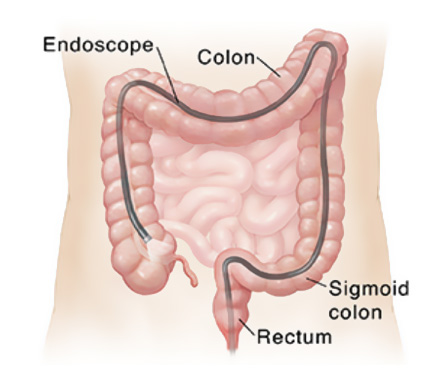Lower GI endoscopy (Colonoscopy)
Lower GI endoscopy allows your healthcare provider to view your lower gastrointestinal (GI) tract. Your entire colon and rectum can be examined (colonoscopy). Or just the rectum and sigmoid colon can be examined (sigmoidoscopy).
An upper endoscopy is used to diagnose and, sometimes, treat conditions that affect the upper part of your digestive system, including the esophagus, stomach and beginning of the small intestine (duodenum).

Before the examination :-
Follow these and any other instructions you are given before your endoscopy. If you don’t follow the healthcare provider’s instructions carefully, the test may need to be cancelled or done over.
- For a colonoscopy, you may be told not to eat and to drink only clear liquids for 1 to 3 days before the exam. Usually it is clear liquids for one day and sometimes other dietary changes even before that, based on your discussion with your healthcare provider.
- Take any laxatives that are prescribed for you. An enema may also be prescribed.
- Arrange for someone to drive you home after the exam if you will be sedated.
- Tell your healthcare provider before the exam if you are taking any medicines, vitamins, supplements, recreational drugs, or have any medical problems.
- Discuss possible alternatives to the procedure, and risks, with your healthcare provider.
The procedure :-
- Colonoscopy can take 30 minutes or longer. Sigmoidoscopy often takes about 20 minutes. The length of the procedure depends a great deal on how clean your intestines are, the reason for the procedure, and what treatments must be done.
- You lie on the stretcher or bed on your left side.
- For colonoscopy, you are given sedating (relaxing) medicine through an IV line. Sigmoidoscopy usually doesn’t need sedation.
- The endoscope is inserted into your rectum. You may feel pressure and cramping. If you feel pain, tell your healthcare provider. You may receive more sedation, which includes pain medicine and an anti-anxiety medicine.
- The endoscope carries images of your colon to a video screen. Prints of the images may be taken as a record of your exam.
- Biopsies (tissue samples), polyp removal, or other treatments may be performed.
- When the procedure is done, you rest for a time. You may have some discomfort right after the procedure from trapped air. This can be relieved by changing position and passing the air. If you have been sedated, you must have an adult drive you home.
